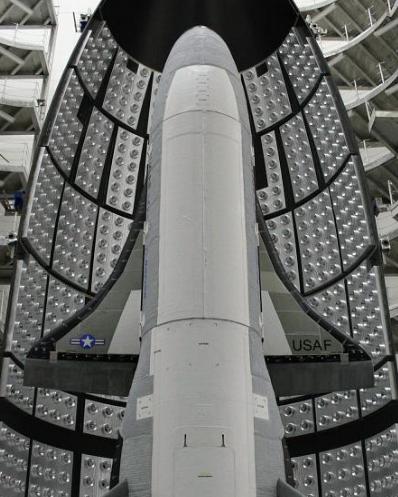This article is more than 1 year old
US Airforce secret spaceplane launched successfully
Other countries: Count your satellites
Why not a lifting-body job this time, then?
NASA says it couldn't use a lifting body on the shuttle as such a large one would be very hard to design - but that wouldn't apply in the case of the little X-37B. Straight stub wings were rejected for the shuttle mainly because the US military wanted to be able to fly it from Vandenberg air force base in California on cunning one-orbit flights that would allow rendezvous with a satellite without anyone being aware that such had taken place. This meant a need for bigger delta wings for "cross range" - the ability to steer sideways during re-entry in order to avoid being left behind by the planet's rotation and coming down in the Pacific.
The X-37B looks very much as though it might be able to perform such a mission, if required. While it is too small to actually capture and bring back another nation's spacecraft in You Only Live Twice style satnappings (except perhaps very small ones) it could easily make a close pass to one without anyone knowing. Most satellites, being focused on their task, have no "situational awareness" of what is happening close by them in space, and a "Mission 3A/3B" X-37B flight on certain spysat style high-angle orbits would be very difficult if not impossible for other nations to monitor from the ground.

Still no lifting body.
Thus the winged X-37B would seem able to get a close visual or electronic look at foreign spacecraft of interest - or perhaps meddle with them using the various new active electronic- and cyber-warfare technologies now coming out - all without flying over any places where it might be tracked by persons not approved of by the US Air Force.
That might offer a clue as to why two such craft have already been ordered when the "fractionated" satellite concept has yet to move out of the design-study stage - and why they have triangular wings rather than straight-stub ones or lifting bodies.
Of course, it's just as plausible that the X-37B looks a bit shuttley simply because it's cheaper to build a mini version of a well-understood machine than do something new. But that doesn't mean the Air Force's original, covert-mission reasons to make the shuttle that shape have gone away. ®
Bootnote
*Future, Fast, Flexible, Fractionated, Free-Flying Spacecraft. The idea is to have the various components of a normal big satellite organised in a wirelessly-linked cluster of small orbiting machines, a so-called virtual satellite. The idea is that this would avoid the expense, limited launch opportunities, inability to upgrade and high risks of critical failure that come with big integrated sats.
